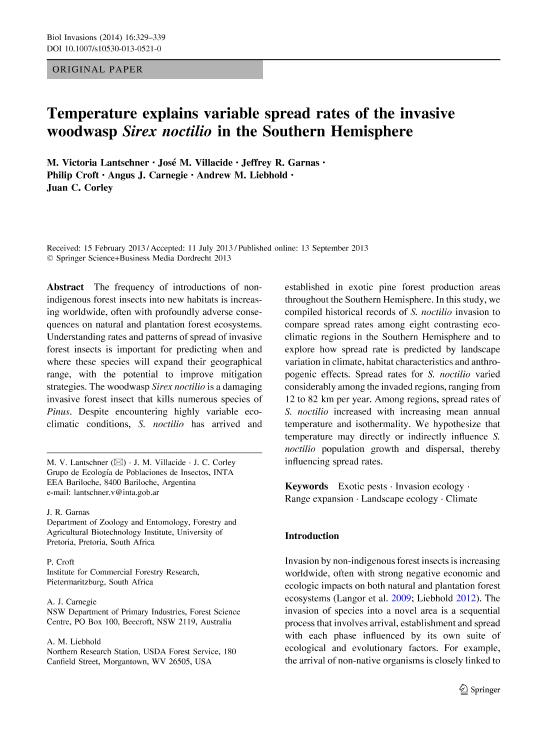Mostrar el registro sencillo del ítem
dc.contributor.author
Lantschner, María Victoria

dc.contributor.author
Villacide, José María

dc.contributor.author
Garnas, Jeffrey R.
dc.contributor.author
Croft, Philip
dc.contributor.author
Carnegie, Angus J.
dc.contributor.author
Liebhol, Andrew M.
dc.contributor.author
Corley, Juan Carlos

dc.date.available
2017-11-07T14:39:06Z
dc.date.issued
2014-02-01
dc.identifier.citation
Lantschner, María Victoria; Villacide, José María; Garnas, Jeffrey R.; Croft, Philip; Carnegie, Angus J.; et al.; Temperature explains variable spread rates of the invasive woodwasp Sirex noctilio in the Southern Hemisphere; Springer; Biological Invasions; 16; 2; 1-2-2014; 329-339
dc.identifier.issn
1387-3547
dc.identifier.uri
http://hdl.handle.net/11336/27720
dc.description.abstract
The frequency of introductions of non-indigenous forest insects into new habitats is increasing worldwide, often with profoundly adverse consequences on natural and plantation forest ecosystems. Understanding rates and patterns of spread of invasive forest insects is important for predicting when and where these species will expand their geographical range, with the potential to improve mitigation strategies. The woodwasp Sirex noctilio is a damaging invasive forest insect that kills numerous species of Pinus. Despite encountering highly variable eco-climatic conditions, S. noctilio has arrived and established in exotic pine forest production areas throughout the Southern Hemisphere. In this study, we compiled historical records of S. noctilio invasion to compare spread rates among eight contrasting eco-climatic regions in the Southern Hemisphere and to explore how spread rate is predicted by landscape variation in climate, habitat characteristics, and anthropogenic effects. Spread rates for S. noctilio varied considerably among the invaded regions, ranging from 12 to 82 km per year. Among regions, spread rates of S. noctilio increased with increasing mean annual temperature and isothermality. We hypothesize that temperature may directly or indirectly influence S. noctilio population growth and dispersal, thereby influencing spread rates.
dc.format
application/pdf
dc.language.iso
eng
dc.publisher
Springer

dc.rights
info:eu-repo/semantics/openAccess
dc.rights.uri
https://creativecommons.org/licenses/by-nc-sa/2.5/ar/
dc.subject
Exotic Pests
dc.subject
Invasion Ecology
dc.subject
Range Expansion
dc.subject
Landscape Ecology
dc.subject
Climate
dc.subject.classification
Bioquímica y Biología Molecular

dc.subject.classification
Ciencias Biológicas

dc.subject.classification
CIENCIAS NATURALES Y EXACTAS

dc.title
Temperature explains variable spread rates of the invasive woodwasp Sirex noctilio in the Southern Hemisphere
dc.type
info:eu-repo/semantics/article
dc.type
info:ar-repo/semantics/artículo
dc.type
info:eu-repo/semantics/publishedVersion
dc.date.updated
2017-09-11T13:59:07Z
dc.journal.volume
16
dc.journal.number
2
dc.journal.pagination
329-339
dc.journal.pais
Alemania

dc.journal.ciudad
Berlin
dc.description.fil
Fil: Lantschner, María Victoria. Instituto Nacional de Tecnología Agropecuaria. Centro Regional Patagonia Norte; Argentina
dc.description.fil
Fil: Villacide, José María. Instituto Nacional de Tecnología Agropecuaria. Centro Regional Patagonia Norte; Argentina
dc.description.fil
Fil: Garnas, Jeffrey R.. University of Pretoria, Forestry and Agricultural Biotechnology Institute; Sudáfrica
dc.description.fil
Fil: Croft, Philip. Institute for Commercial Forestry Research; Sudáfrica
dc.description.fil
Fil: Carnegie, Angus J.. Forest Science Centre, NSW Department of Primary Industries; Australia
dc.description.fil
Fil: Liebhol, Andrew M.. Northern Research Station; Estados Unidos
dc.description.fil
Fil: Corley, Juan Carlos. Instituto Nacional de Tecnología Agropecuaria. Centro Regional Patagonia Norte; Argentina
dc.journal.title
Biological Invasions

dc.relation.alternativeid
info:eu-repo/semantics/altIdentifier/url/https://link.springer.com/article/10.1007/s10530-013-0521-0
dc.relation.alternativeid
info:eu-repo/semantics/altIdentifier/doi/http://dx.doi.org/10.1007/s10530-013-0521-0
Archivos asociados
